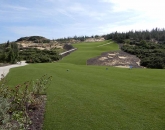
What of the course setup? What speed should the greens run? How wide should the fairways be? What about the height of the rough? What is deemed a bunker and what is not?
In theory (but not always in practice) the green speed should be relative to the severity of the green contour. The more contoured the green the slower you want the green speed. At any event green speeds are faster for tournament play than regular play. This means that the grass is cut lower during tournament play, which in turn adds more stress to that grass. Over long periods, and where frequent play is common, having fast green speeds is not advisable. Even over shortened periods - as seen at the US Open at Shinnecock Hills in 2004, for example - fast greens speeds can compromise the integrity of the grass in a matter of hours.
During tournament play the general thinking is to reduce the fairway width (sometimes as little as 15-20 yards at the landing areas) to place the onus on accuracy. In this case grassing lines are reconfigured making some golf features benign - a point in case being at last year’s US Open at Merion where numerous bunkers were as much as 15 yards in the rough.
My personal preference is to see wider fairways in tournament and general play but that it’s important the strategy determines you favour one side of the fairway. I have always held the view that the wider the fairway the more golf terrain you can show off and the more strategic you can make the test … not to mention the more playable the golf course becomes. Having said that I still view rough as an important golf feature and it’s not uncommon to find it at ankle height during tournament play.
If in this kind of rough even the best golfers will find it almost impossible to predict what the ball is going to do upon landing. This is no bad thing in that it promotes the need to survey the fairway and green surrounds to see how they can use the slopes to positively propel their ball towards the target. They are no longer focused on a small target; rather they are “forced” to look at the big picture and in doing so start to harvest some creative thought. Of course if the golf course were set-up to be narrow and dominated by high rough every single day then I bet a round would take 10 hours and the level of frustration would exceed 10, so this situation is not really feasible. The ideal is that you don’t have to drastically change the day-to day-course set-up to make it fun and challenging for the best golfers during tournament play … there’s the trick
I really don’t like the words “championship golf course”. It’s almost as if you are bracketing the fact that the only thing the golf course is good for is hosting a tournament. At the end of the day if the architect strives to create a golf experience loaded with variety then there is no doubt that that golf course will be championed by the very best and the rest.
On a side note I believe we should strive - during tournament play and general play - to have the ground play hard and fast - much like you see at the Open Championship each year. I am conscious this may not always be possible but a course that plays firm will be much more interesting and certainly more testing than a course set up to play soft and receptive.
Paul Jansen is the principal architect for Jansen Golf Design. To learn more visit www.jansengolfdesign.com
Pages
Click here to see the published article.











